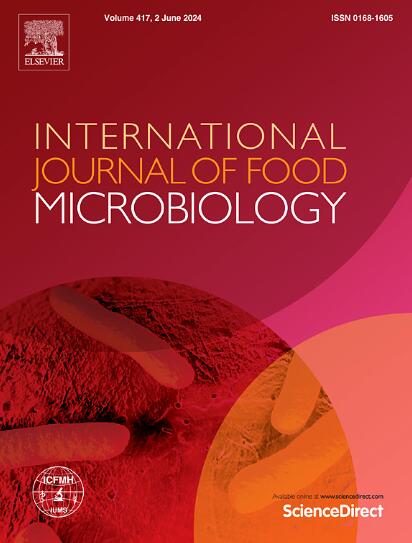海南槟榔加工过程中真菌组成的动态变化及水分活性对优势霉菌种类的影响
IF 5.2
1区 农林科学
Q1 FOOD SCIENCE & TECHNOLOGY
International journal of food microbiology
Pub Date : 2025-06-03
DOI:10.1016/j.ijfoodmicro.2025.111300
引用次数: 0
摘要
槟榔果是中国历史上最具代表性的咀嚼产品之一,但它面临着有害微生物生长带来的产品安全和质量问题的挑战。为了阐明这些微生物威胁的机制并制定有针对性的控制策略,本研究分析了海南槟榔加工阶段的动态微生物特征。对海南槟榔不同加工阶段α多样性和总真菌计数进行了监测。成品中TFC(1.725 ± 0.046 Lg CFU/g)和真菌种类多样性显著增加,这可能与人工操作和加工后期的环境暴露有关。分离出TFC最高的10株霉菌,并在槟榔粉培养基上进行筛选。通过系统发育分析,分离出两个优势霉菌种,分别为橡胶曲霉(Aspergillus rubber)和赭曲霉(Aspergillus ochraceus)。不同水活度(Aw)下的生长曲线表明,当Aw = 0.798和0.815时,两种优势霉菌的生长均受到抑制。在槟榔果制品中再接种这些物种(aw0.80)进一步表明,降低的Aw显著抑制了它们的生长速度。这些结果可能对预测和延长槟榔果产品的保质期有重要的贡献。本文章由计算机程序翻译,如有差异,请以英文原文为准。
Dynamic changes in fungal composition during the processing of Hainan areca nut and effects of water activity on dominant mold species
Areca nut, one of the most historically representative chewing products in China, faces challenges from harmful microbial growth that causes both product safety and quality problems. To elucidate the mechanism underlying these microbial threats and develop targeted control strategies, this study analyzed dynamic microbial profiles of Hainan areca nuts during the processing stages. Alpha diversity analysis and total fungal counts (TFC) of Hainan areca nuts were monitored during different processing stages. A significant increase in TFC (1.725 ± 0.046 Lg CFU/g) and diversity of fungal species was observed in the finished product (FP), which might be attributed to manual operation and environmental exposure during the final processing stages. Ten strains of mold with the highest TFC were isolated and further screened on the areca nut powder culture medium. Two dominant mold species were isolated and identified by phylogenetic analysis, and were demonstrated to be Aspergillus ruber and Aspergillus ochraceus. Growth curves under varying water activities (Aw) indicated that the grows of two dominant mold species were inhibited at Aw of 0.798 and 0.815, respectively. Reinoculation of these species in areca nut products (Aw 0.80) further demonstrated that reduced Aw significantly suppressed their growth rates. These results may critically contribute to the prediction and extension of the shelf-life of areca nut products.
求助全文
通过发布文献求助,成功后即可免费获取论文全文。
去求助
来源期刊
CiteScore
10.40
自引率
5.60%
发文量
322
审稿时长
65 days
期刊介绍:
The International Journal of Food Microbiology publishes papers dealing with all aspects of food microbiology. Articles must present information that is novel, has high impact and interest, and is of high scientific quality. They should provide scientific or technological advancement in the specific field of interest of the journal and enhance its strong international reputation. Preliminary or confirmatory results as well as contributions not strictly related to food microbiology will not be considered for publication.

 求助内容:
求助内容: 应助结果提醒方式:
应助结果提醒方式:


